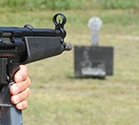Safety is the first factor that should be considered. If you research steel target safety on the internet, you will find a wide variety of information on this subject. I suggest you browse the forum posts on this subject but don’t put too much authority in sources if you can’t verify their credentials. Without spending too much time on this subject, we can break down safety into several key points:
- Always where safety glasses when shooting ANY steel targets.
- Only shoot AR550 or AR500 targets purchased from manufacturers that you trust. Review the manufacturer’s web site. Who are their customers? If they are selling military targets and law enforcement targets, they most likely have the manufacturing processes in place to ensure consistent quality and safety standards.
- Make sure you follow the manufacturers recommended shooting distances. Challenge Target’s steel safety directions specify a minimum distance of 7 yards for handgun targets and a minimum distance of 50 yards to 100 yards for rifle targets (depending on the model).
- Use the right ammunition. Never use armor piercing bullets, green tip bullets, steel core bullets, or steel shot when shooting metal targets. Standard FMJ rounds are suitable for all our targets.
- Select targets from trusted manufacturers that are designed and extensively tested to consistently deflect bullet fragments in a safe direction.
Other Factors To Consider When Selecting A Steel Targets
Portability and ease of set-up are also important when choosing your target. Think about where you plan to shoot. Will you leave your targets on the range? Will you be moving the targets to different locations on the range? Will you be transporting them in a passenger vehicle? One of the most common mistakes people make is buying a target that’s too heavy and immobile for their needs. We often see expensive,reactive targets buried in the back of a storage shed or garage because people get tired of moving them to and from (or on and off) the range. Top target manufacturers will list the product weights on their web site. Also consider how easy or difficult it is to break the system down for transportation or winter storage.
The next consideration when selecting a steel target is the upright support mechanism. Manufacturers typically approach this one of two ways. One solution is to design and build the vertical support pieces using steel for durability. A common material used for this component is ¼” thick angle iron. This construction adds weight to the target system and reduces the flexibility because the height isn’t adjustable. That being said, steel uprights are durable when used on pistol targets and won’t require much maintenance. This design, however, will not work well on a rifle target. Most centerfire rifles (including .223 caliber) will easily penetrate and damage angle iron up to ¾” thick. A second solution is to use an inexpensive, replaceable upright support such as wood. Target stands that accept wood uprights, allow the shooter to customize the height of the armor plate by varying the length post. This design also reduces the product weight, package size and associated shipping cost. Wood posts last much longer than most people expect. In fact, there is a common event in SWAT competitions called the “lumberjack” where 3-5 SWAT members face off with other departments to see which team can cut through a wood post with their duty weapon fastest. The distance is set at about 10 yards and it usually takes close to 100 well placed shots to destroy the wood. Check out this independent video:
If you decide to move forward with a steel target that utilizes a wood post, we suggest a design where the 3-1/2” dimension of the wood faces the shooter. This has yielded the best results in our extensive testing. Also, make sure the wood post is parallel to the surface of the steel plate, otherwise, bullet fragments off the steel will destroy the wood.




